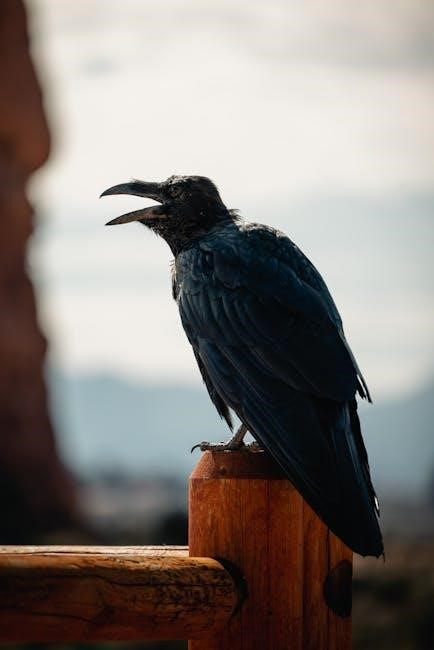Antelope Canyon, nestled in the American Southwest, is a breathtaking slot canyon known for its vibrant colors and serene atmosphere. While self-guided tours are not permitted within the canyon itself due to its protected status on Navajo Nation land, visitors can explore its stunning landscapes through authorized tours or alternative adventures like kayaking and hiking. This guide offers insights into planning your visit, tips for capturing memorable photos, and essential information to make the most of your Antelope Canyon experience.

Overview of Antelope Canyon
Antelope Canyon, located in Arizona, is one of the most iconic natural wonders in the American Southwest. Known for its breathtaking slot canyon formations, it is a must-visit destination for nature enthusiasts and photographers. The canyon is divided into two main sections: Upper Antelope Canyon and Lower Antelope Canyon. Upper Antelope Canyon, also known as “The Crack,” is famous for its light beams that illuminate the canyon floor, creating stunning visual effects. Lower Antelope Canyon, or “The Corkscrew,” offers a more adventurous experience with its winding tunnels and unique rock formations. Both sections are part of the Navajo Nation and require permits for access. The canyon’s vibrant colors and sculpted walls, carved over millions of years by erosion, make it a testament to the power of nature. Its unique beauty attracts visitors worldwide, making it a cornerstone of Arizona’s natural heritage.
Why Antelope Canyon is a Must-Visit Destination
Antelope Canyon is a must-visit destination due to its unparalleled natural beauty and unique geological formations. Its stunning slot canyons, carved by centuries of erosion, display vibrant colors and intricate patterns that captivate visitors worldwide. The canyon’s iconic light beams, which illuminate the sandstone walls, create breathtaking photo opportunities, making it a paradise for photographers. Beyond its visual appeal, Antelope Canyon holds spiritual significance for the Navajo Nation, offering a deeper connection to nature and culture. Whether you’re an adventure seeker, a nature lover, or a photography enthusiast, the canyon’s awe-inspiring landscapes and serene atmosphere provide an unforgettable experience. Its reputation as one of the most photographed locations in the world ensures that it remains a once-in-a-lifetime destination for travelers seeking to explore the natural wonders of the American Southwest.
Guided vs. Self-Guided Tours: Understanding the Options
When planning a visit to Antelope Canyon, travelers must decide between guided and self-guided tours. Guided tours are led by experienced Navajo guides who provide insights into the canyon’s history, geology, and cultural significance. They often include transportation and prioritize safety, especially during flash flood risks. Self-guided tours, however, offer more flexibility and independence, allowing visitors to explore at their own pace. These tours are ideal for those who prefer solitude or want to spend extra time capturing photos. While guided tours are more structured, self-guided options appeal to adventurous travelers seeking a hands-on experience. Understanding your preferences for guidance, flexibility, and budget will help determine the best choice for your Antelope Canyon adventure.
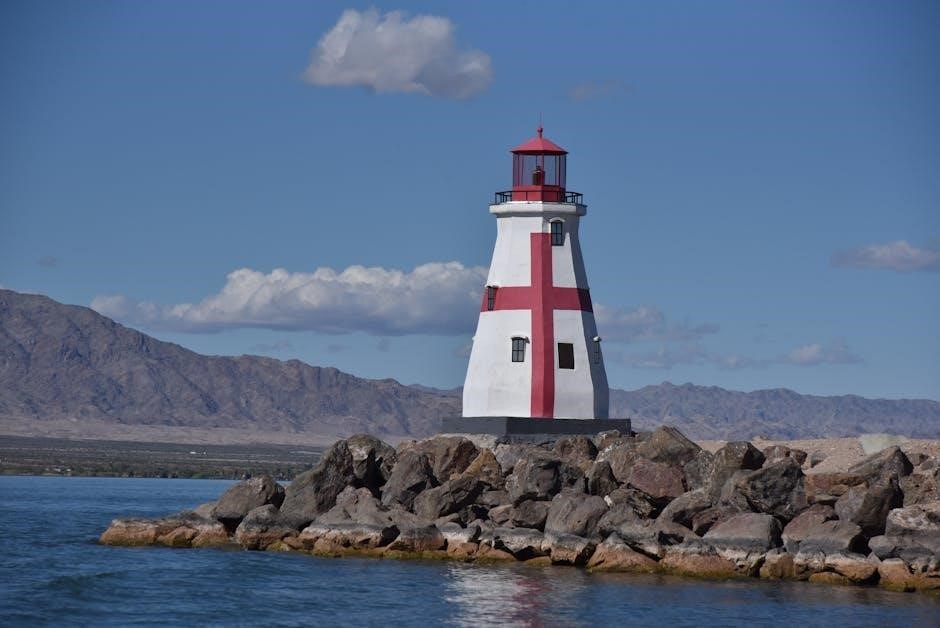
Planning Your Self-Guided Tour
Planning your self-guided tour requires research, choosing the right time, and preparing essentials like water, snacks, and proper footwear for a smooth, enjoyable experience.
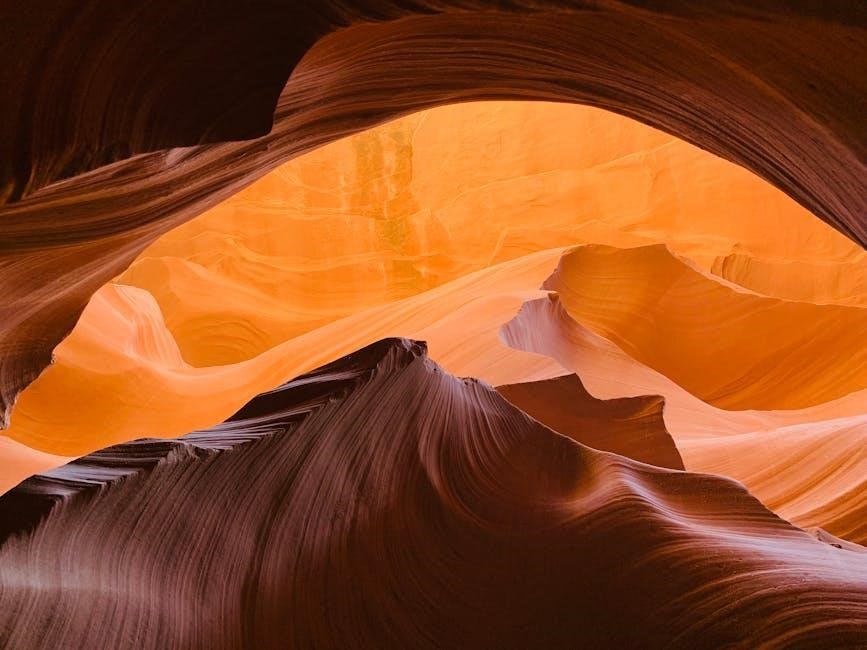
Choosing Between Upper and Lower Antelope Canyon
Upper Antelope Canyon is known for its iconic light beams and wide, accessible passages, making it ideal for photography and families. Lower Antelope Canyon offers a more adventurous experience with narrower pathways and unique rock formations. Upper Canyon requires a short, easy walk, while Lower Canyon involves climbing ladders and navigating stairs, which may be challenging for some. Consider your physical abilities and interests when deciding. Both canyons are stunning, but Upper is generally more popular for its breathtaking visuals, while Lower provides a quieter, immersive experience. Book early, as permits are required for both, and plan according to your preferences for ease of access or adventure.
The Importance of Permits for Access
Accessing Antelope Canyon requires a permit, as it is located on Navajo Tribal Park land. Permits ensure the canyon is preserved and visited responsibly. Both Upper and Lower Canyons need authorization, and self-guided tours must obtain a permit in advance. These permits help manage visitor numbers, protecting the fragile environment and ensuring safety. Without a valid permit, entry is strictly prohibited. Plan ahead, as permits often sell out quickly, especially during peak seasons. Guided tours typically include permits, but for self-guided visits, secure yours through authorized sources to avoid issues. Remember, permits are non-refundable, so check weather and tour conditions before booking. They are essential for a legal and enjoyable experience, respecting both the land and Navajo traditions.
Essential Tips for a Successful Self-Guided Tour
To ensure a smooth and enjoyable self-guided tour of Antelope Canyon, proper preparation is key. Bring sturdy shoes, water, and snacks, as services are limited near the canyon. A map or GPS device is crucial for navigation, especially in remote areas. Arrive early to avoid crowds and make the most of your time. Respect the canyon’s natural beauty by staying on designated paths and avoiding vandalism. Flash floods can occur, so monitor weather forecasts and avoid visiting during heavy rain. Be prepared for uneven terrain and tight spaces, and stay alert for safety. Lastly, bring a fully charged camera to capture stunning photos. By planning ahead and being mindful of your surroundings, you can fully immerse yourself in the breathtaking beauty of Antelope Canyon.
Exploring Upper Antelope Canyon
Upper Antelope Canyon, known as “The Crack,” offers a breathtaking, easily accessible landscape with stunning light beams, perfect for photography during a self-guided tour.
Unique Features of Upper Antelope Canyon
Upper Antelope Canyon, often referred to as “The Crack,” boasts stunning geological formations carved by millions of years of erosion. Its narrow, winding passageways are adorned with breathtaking patterns created by the interplay of light and sandstone. The canyon’s smooth, flowing walls, shaped by flash floods, feature iconic “corkscrew” and “flame” shapes. Unlike Lower Antelope Canyon, Upper Antelope is more accessible, with shorter hikes and fewer stairs, making it ideal for self-guided exploration. The dramatic beams of light that illuminate the canyon during midday are a photographer’s paradise, capturing the vibrant colors and textures of the natural wonder; For visitors on a self-guided tour, Upper Antelope offers an unforgettable experience, blending ease of access with awe-inspiring beauty.
Best Times to Visit Upper Antelope Canyon
The optimal time to visit Upper Antelope Canyon for a self-guided tour is during the spring and fall seasons when temperatures are mild, making exploration more comfortable. Summer months can be extremely hot, while winters may bring snow, complicating access. For photography enthusiasts, midday is the prime time, as the sunlight beams that filter through the canyon’s openings are at their most dramatic, creating stunning visual effects. Early morning or late afternoon visits are recommended to avoid crowds, allowing for a more peaceful and immersive experience. Planning your visit during these periods ensures you can fully appreciate the canyon’s natural beauty without the hustle and bustle of peak hours.
Photography Tips for Upper Antelope Canyon
Photography enthusiasts will find Upper Antelope Canyon a paradise, but capturing its beauty requires careful planning. A tripod is essential for stabilizing your camera in low-light conditions, while a wide-angle lens helps frame the vast, intricate rock formations. Shoot in manual mode to adjust exposure and white balance, as the canyon’s dramatic lighting can challenge auto settings. Consider using a neutral density (ND) filter to manage harsh sunlight. Midday sunbeams create iconic shots, but arrive early or late to avoid crowds. Experiment with long exposures to blur sand particles in the air, adding a dynamic effect. Respect the environment by not touching the walls, and stay patient—perfect shots often require timing and persistence. These tips will help you capture the canyon’s breathtaking beauty effectively during your self-guided tour;
Discovering Lower Antelope Canyon
Explore the adventurous trails and breathtaking landscapes of Lower Antelope Canyon. Its unique rock formations and less crowded paths offer a thrilling self-guided exploration experience.
Unique Features of Lower Antelope Canyon
Lower Antelope Canyon, often called “Hasdeztwazi” or “Spiral Rock Arch Canyon,” boasts stunning narrow passageways and intricate rock formations. Its unique “corkscrew” shapes, created by millions of years of erosion, captivate visitors. Unlike Upper Antelope Canyon, Lower Canyon offers a more adventurous experience with its longer trails and deeper depths. The canyon’s vibrant red and orange hues are enhanced by natural light filtering through the narrow openings above. Its less crowded nature makes it a favorite for self-guided explorers seeking a peaceful, immersive experience. The canyon’s winding paths and dramatic curves provide endless opportunities for photography and reflection. This natural wonder is a testament to the region’s geological history and Navajo heritage, making it an unforgettable destination for any traveler.
Adventure Opportunities in Lower Antelope Canyon
Lower Antelope Canyon offers a thrilling adventure for self-guided explorers, with its narrow, winding passageways and rugged terrain. Unlike Upper Canyon, Lower Canyon provides a more physically engaging experience, requiring visitors to climb ladders and navigate uneven surfaces. The canyon’s deeper depths and longer trails allow for a sense of discovery, as if uncovering hidden natural wonders. For the adventurous, the opportunity to squeeze through tight crevices and marvel at the dramatic rock formations is unparalleled. Photography enthusiasts can also capture unique, dramatic lighting effects in the canyon’s depths. This section of the canyon is perfect for those seeking a more immersive and active experience, making it a standout choice for self-guided tours;
Accessibility Considerations for Lower Antelope Canyon
Lower Antelope Canyon presents unique accessibility challenges due to its narrow passageways, steep staircases, and rugged terrain. Visitors must navigate ladders and uneven surfaces, making it less suitable for individuals with mobility impairments or physical limitations. The canyon’s deeper depths also mean longer walks and more strenuous climbs compared to Upper Antelope Canyon. For self-guided tours, it’s essential to assess your physical ability before attempting to explore Lower Canyon. While the adventure is rewarding, it’s not ideal for young children, elderly visitors, or those requiring assistance. Guided tours may offer better support for those with specific needs. Always check current conditions and accessibility guidelines before planning your visit to ensure a safe and enjoyable experience.
The Self-Guided Tour Experience
A self-guided tour offers independence and flexibility, allowing visitors to explore Antelope Canyon at their own pace, immersing in its natural beauty and unique formations without time constraints.
Navigating the Canyon on Your Own
Navigating Antelope Canyon independently requires careful preparation and awareness of your surroundings. The canyon’s narrow passages and winding trails can be challenging, especially without a guide. It’s essential to stay alert and cautious, as the terrain can be uneven and slippery in some areas. Visitors should bring a reliable map or use a downloaded guide to avoid getting lost. Proper footwear and water are must-haves, as exploring the canyon can be physically demanding. While the freedom of a self-guided tour allows for a more personalized experience, it’s crucial to respect the natural environment and follow safety guidelines. The breathtaking scenery and unique formations make the effort worthwhile, offering a rewarding adventure for those willing to take on the challenge.
Safety Tips for a Solo Visit
When exploring Antelope Canyon on your own, prioritize safety to ensure a smooth and enjoyable experience. Always check the weather forecast beforehand, as flash floods can occur unexpectedly. Carry a reliable flashlight or phone light to navigate dark passages, and stay within marked trails to avoid accidents. Inform someone about your itinerary, including your expected return time, in case of emergencies. Bring plenty of water and snacks, as services may be limited. Avoid climbing or touching sensitive rock formations to preserve the canyon and ensure personal safety. Be mindful of uneven terrain and take your time when moving through narrow spaces. Lastly, keep an eye on your belongings and stay alert, especially in crowded areas. Preparation and awareness are key to a safe and memorable solo visit.

Capturing Memorable Moments
Capturing the breathtaking beauty of Antelope Canyon during your self-guided tour requires thoughtful planning and attention to detail. To make the most of your photography, visit during the midday hours when sunlight beams illuminate the canyon, creating stunning visual effects. Use a tripod to stabilize your camera for sharper images, especially in low-light conditions. Experiment with wide-angle shots to capture the grandeur of the canyon, and don’t hesitate to take close-ups of unique rock formations. Consider using a polarizing filter to enhance colors and reduce glare. Be patient and wait for moments when the light highlights the textures and patterns of the canyon walls. Above all, take your time to absorb the beauty and let your camera tell the story of this natural wonder.
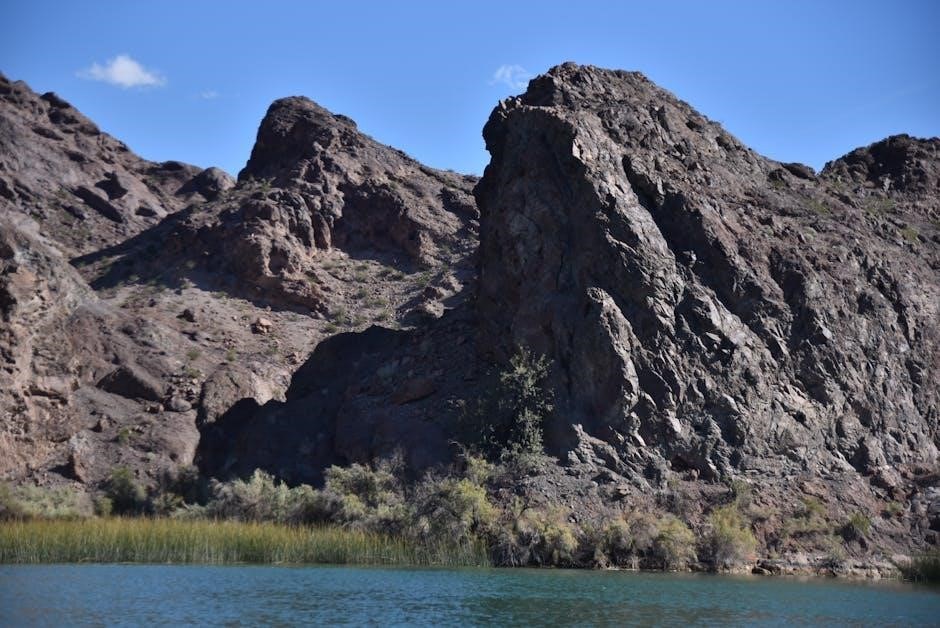
Photography in Antelope Canyon
Antelope Canyon offers breathtaking visuals, with its swirling rock formations and vibrant colors. To capture stunning photos, consider visiting during optimal lighting conditions and experimenting with angles. A tripod and wide-angle lens can enhance your shots, while patience allows you to frame the perfect moment. The canyon’s unique textures and natural light create unforgettable imagery, making it a photographer’s paradise. Take your time to explore and let your camera immortalize the beauty of this natural wonder.
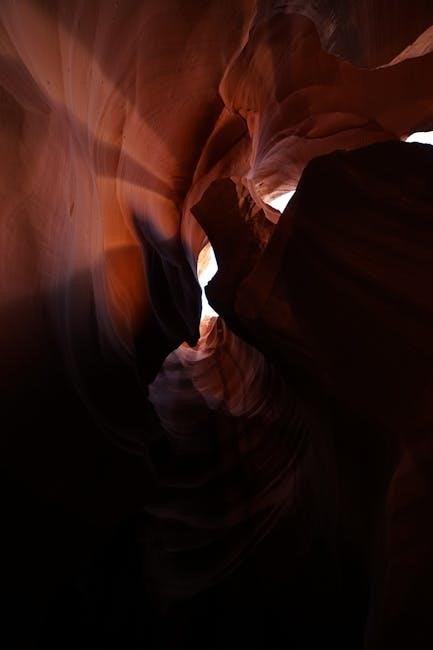
Lighting Conditions for Optimal Photos
Lighting is crucial for capturing the breathtaking beauty of Antelope Canyon. The best photos are taken during midday when sunlight filters through the narrow openings, creating dramatic beams of light. These beams are most pronounced in Upper Antelope Canyon, particularly during summer months when the sun is highest. For Lower Antelope Canyon, the light is softer and more diffused, offering unique opportunities for creative shots. To avoid harsh shadows, visit during overcast days or later in the afternoon. Timing your self-guided tour around these conditions ensures vibrant, well-lit images. Be patient and wait for the perfect moment when the light highlights the canyon’s textures and colors, making your photos truly unforgettable.
Best Camera Settings for Capturing the Canyon
To capture the stunning beauty of Antelope Canyon, use camera settings that emphasize its vibrant colors and textures. Shoot in RAW format for better flexibility in post-processing. Use a wide aperture (f/2.8 or lower) to let in more light, especially in the canyon’s darker areas. A low ISO (100-400) is ideal to minimize noise, but adjust if lighting is challenging. Set white balance to “Cloudy” or “Shade” to enhance the warm tones of the canyon. Use a fast shutter speed (1/125s or faster) to freeze light beams and avoid blur. Experiment with bracketing to capture high-contrast scenes. Bring a tripod for stability in low-light conditions and consider a polarizing filter to reduce glare and enhance colors. These settings will help you preserve the canyon’s intricate details and natural beauty in your photos.
How to Avoid Crowds for Better Shots
To avoid crowds and capture stunning photos, plan your visit strategically. Opt for early morning or late afternoon tours when fewer people are present. Weekdays are generally less busy than weekends. Arrive early at the canyon to secure parking and start your exploration before the peak hours. Consider visiting during the off-season (November to March) for a quieter experience. Be patient and wait for groups to move out of frame before taking your shots. Explore less-traveled areas within the canyon to find unique angles without the crowds. By timing your visit wisely and being mindful of others, you can enjoy a more peaceful and photogenic experience at Antelope Canyon.
Safety First: Navigating Antelope Canyon
Navigating Antelope Canyon requires caution and awareness. Stay alert to your surroundings, avoid restricted areas, and wear proper footwear. Bring water and a map for emergencies. Stay safe and informed during your self-guided tour.
Understanding Flash Flood Risks
Flash floods are a significant hazard in Antelope Canyon, particularly during monsoon season (July–September). These sudden water surges can occur even with clear skies due to distant storms; Always check weather forecasts before entering the canyon and monitor conditions closely. Look for warning signs like rising water levels, unusual sounds, or distant thunder. Carry a reliable flashlight or headlamp in case visibility decreases. If flooding occurs, seek higher ground immediately and avoid wading through fast-moving water. Stay informed about local weather advisories and plan your visit accordingly. Flash floods can be deadly, so it’s crucial to exercise extreme caution and heed warnings from authorities or guides; Never underestimate the power of these natural events. Stay prepared and aware to ensure a safe and enjoyable experience.
Monitoring Weather Conditions
Monitoring weather conditions is essential for a safe and enjoyable self-guided tour of Antelope Canyon. The canyon is prone to flash floods, especially during monsoon season (July–September), when rain in distant areas can cause sudden water surges. Always check local weather forecasts before and during your visit. Avoid entering the canyon if there are signs of approaching storms, such as dark clouds or thunder. Use a reliable weather app to stay updated on conditions in real-time. If you notice rapid changes, such as increasing wind or dropping temperatures, exit the canyon immediately. Rangers and local authorities often close the canyon during bad weather, so respect these closures for your safety. Stay informed and prepared to adapt your plans based on weather conditions to ensure a secure and memorable experience;
Eco-Friendly Practices to Preserve the Canyon
Preserving Antelope Canyon’s natural beauty is crucial for future generations. When embarking on a self-guided tour, adopt eco-friendly practices to minimize your impact on the environment. Stay on designated trails to avoid damaging the fragile rock formations and vegetation. Avoid touching the canyon walls, as oils from skin can alter the natural colors and texture. Carry all trash with you and dispose of it properly to maintain the pristine conditions of the area. Refrain from using chemicals, such as lotions or sprays, before entering the canyon, as they can harm the ecosystem. Additionally, conserve water by minimizing its use during your visit. Respect wildlife and avoid disturbing any plants or animals. By being mindful of your actions, you contribute to the long-term conservation of this incredible natural wonder.
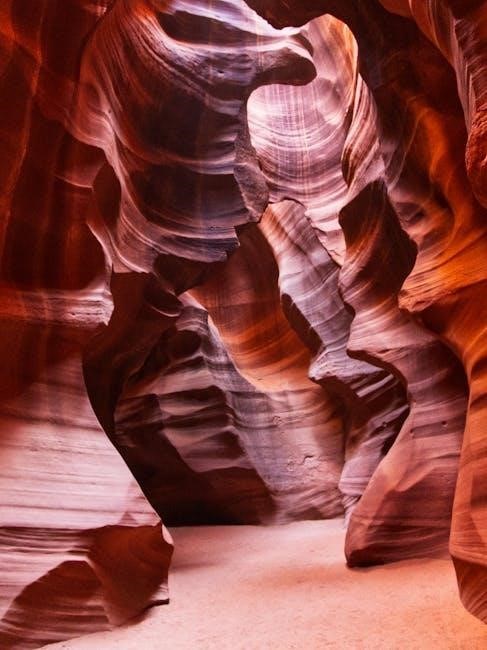
Guided vs. Self-Guided Tours: A Comparison
Guided tours offer expert insights, convenience, and safety, while self-guided tours provide flexibility and independence, allowing visitors to explore Antelope Canyon at their own pace and preference.
Pros and Cons of Each Tour Type
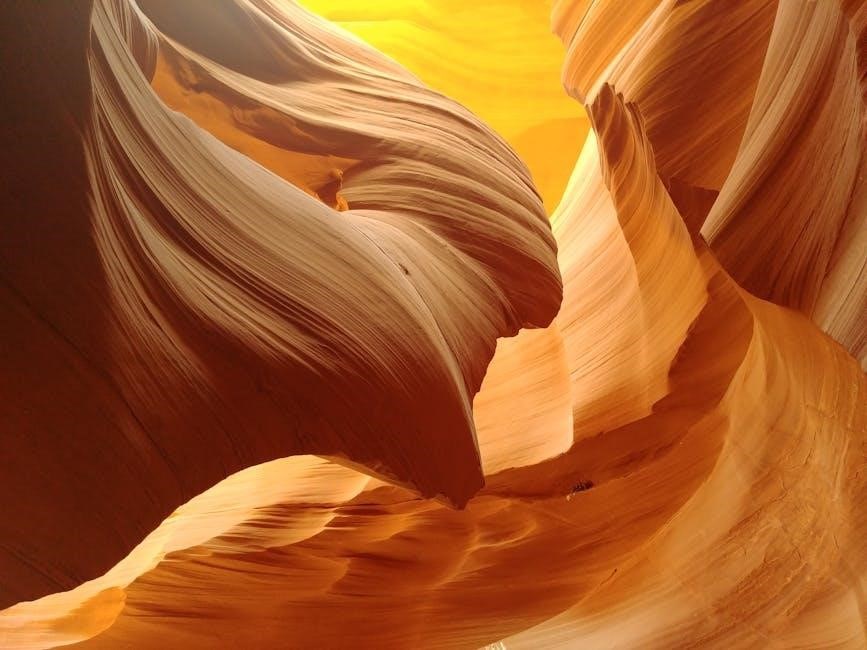
Guided tours provide expert knowledge, ensuring visitors understand the canyon’s history and unique formations, while offering safety and convenience. However, they can be more expensive and less flexible. Self-guided tours allow for personal exploration at your own pace, often costing less, but lack expert insights and may pose safety risks without proper preparation. Guided tours are ideal for those seeking educational value and reassurance, while self-guided tours suit adventurous individuals who value independence and cost-efficiency. Each option caters to different preferences, balancing convenience, cost, and autonomy;
Cost Comparison: Guided vs. Self-Guided
Guided tours of Antelope Canyon typically range from $80 to $150 per person, depending on the length and type of tour. Self-guided tours are generally more affordable, with access fees around $25 to $40 per person, plus a $8 Navajo Nation permit. However, self-guided visitors must arrange their own transportation to the canyon; Guided tours often include transportation, entrance fees, and professional insights, making them a more comprehensive but pricier option. For budget-conscious travelers, self-guided tours offer significant savings, but without the added benefits of a guide. Ultimately, the choice depends on whether the convenience and expertise of a guide justify the higher cost.
Choosing the Right Option for Your Preferences
When deciding between a guided or self-guided tour of Antelope Canyon, consider your priorities and preferences. Guided tours are ideal for those who value expert knowledge, convenience, and hassle-free navigation. Guides provide insights into the canyon’s history, geology, and best photo spots, making them perfect for first-time visitors or photography enthusiasts. Self-guided tours, however, offer flexibility and independence, appealing to adventurous travelers who enjoy exploring at their own pace. If you’re looking for a more personalized experience and don’t mind sacrificing some freedom, a guided tour may be the better choice. Conversely, if you prefer autonomy and are comfortable with minimal guidance, a self-guided tour allows you to immerse yourself in the canyon’s beauty without time constraints.
Antelope Canyon offers an unforgettable self-guided tour experience, blending natural beauty with photography opportunities. Plan carefully, respect the environment, and capture timeless memories responsibly.
Planning a self-guided tour of Antelope Canyon requires careful preparation to ensure a safe and memorable experience. Start by choosing between Upper and Lower Antelope Canyon, each offering unique landscapes and challenges. Obtain necessary permits well in advance, as access is restricted without them. Understand the differences between guided and self-guided tours, weighing factors like cost, flexibility, and expert insights. Be aware of potential risks such as flash floods and monitor weather conditions closely. Capture stunning photos by optimizing lighting and camera settings, while avoiding crowds for better shots. Lastly, practice eco-friendly practices to preserve the canyon’s natural beauty. By addressing these considerations, you can fully enjoy the breathtaking beauty of Antelope Canyon responsibly.
Final Tips for a Memorable Visit
To make your self-guided tour of Antelope Canyon unforgettable, arrive early to avoid crowds and maximize your exploration time. Bring water, snacks, and a first-aid kit, as services may be limited nearby. Respect the canyon’s fragile environment by staying on designated paths and avoiding vandalism. Take moments to appreciate the natural beauty and unique formations, rather than rushing through. For photography enthusiasts, pack a tripod and extra batteries to capture the stunning light beams and textures. Wear comfortable, sturdy footwear for navigating the terrain, especially in Lower Antelope Canyon; Lastly, stay mindful of time to ensure you explore thoroughly without feeling rushed. By being prepared and respectful, you’ll create lasting memories of this incredible natural wonder.

